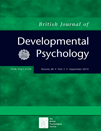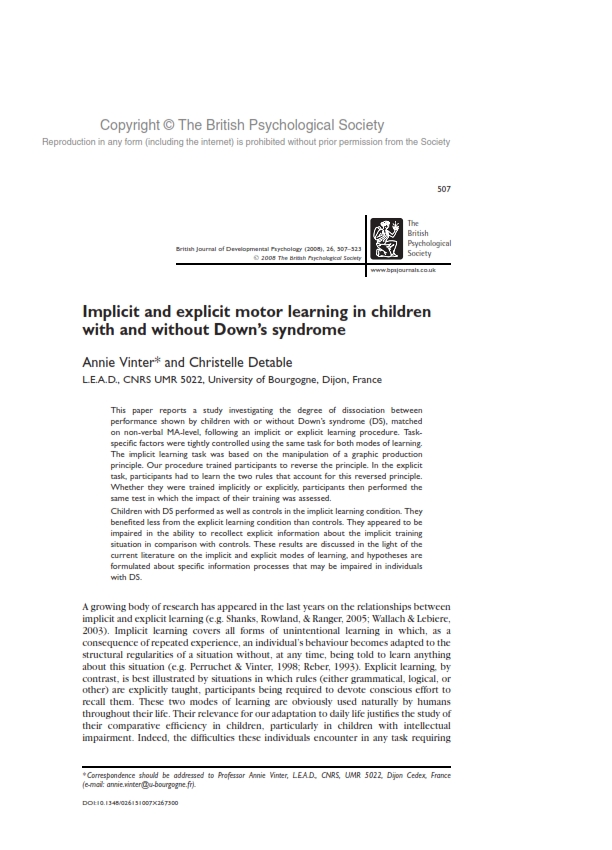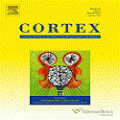ترجمه عنوان مقاله به فارسی:
یادگیری حرکتی ضمنی و صریح در کودکان مبتلا به سندرم دوان وبدون سندرم داون
≡ مشخصات و منبع مقاله
≡ مشخصات و منبع مقاله

عنوان انگلیسی مقاله:
Implicit and explicit motor learning in children with and without Down’s syndrome
:نویسندگان
Annie Vinter* and Christelle Detable
L.E.A.D., CNRS UMR 5022, University of Bourgogne, Dijon, France
:چکیده انگلیسی مقاله
abstract:
This paper reports a study investigating the degree of dissociation between performance shown by children with or without Down’s syndrome (DS), matched on non-verbal MA-level, following an implicit or explicit learning procedure. Taskspecific factors were tightly controlled using the same task for both modes of learning. The implicit learning task was based on the manipulation of a graphic production principle.
Our procedure trained participants to reverse the principle. In the explicit task, participants had to learn the two rules that account for this reversed principle. Whether they were trained implicitly or explicitly, participants then performed the same test in which the impact of their training was assessed.
Children with DS performed as well as controls in the implicit learning condition. They benefited less from the explicit learning condition than controls. They appeared to be impaired in the ability to recollect explicit information about the implicit training situation in comparison with controls.
These results are discussed in the light of the current literature on the implicit and explicit modes of learning, and hypotheses are formulated about specific information processes that may be impaired in individuals
Method
Participants
The final sample consisted of 28 right-handed children (13 females) with DS and 28 right-handed control children (14 females). The children with DS complied with the criteria for the diagnosis of mental retardation according to the Diagnostic and Statistical Manual of Mental Disorders (DSM-IV) (American Psychiatric Association, 1994) and had IQs between 30 and 70.
A larger number of children were actually recruited than were included in the analysis (DS children, N at outset ¼ ۳۲; controls, N at outset ¼ ۳۹). The selection was based on two criteria. First, we retained only participants who spontaneously applied the start-rotation principle in a minimum of 7 out of 12 cases in the tracing task they received before training.
Four children with DS and five controls were not included in the study for this reason.Second, typically developing children were matched on mental age (MA) to children with DS. This criterion also resulted in some control children being left out, as detailed below.
An assessment of MAs was made using a non-verbal test, the Kohs Block Design Test (Kohs, 1920; French adaptation, 1972).The choice for the matching strategy was based on an assessment of non-verbal performance, as both the implicit training task and the test consisted of mainly non-verbal components.
The DS participants were aged between 7;9 and 13;7, with a mean age of 11;4. The controls were aged between 4;8 and 7;5 (mean age ¼ ۵; ۱۱).None of the participants had a known secondary physical or sensory impairment. Parental consent was obtained for each child.
Both groups of children were divided into two learning groups, 14 children receiving implicit instructions and 14 explicit, in such a way that mean chronological age and mean MA were similar in both groups between the implicit and explicit learners.
Furthermore, from the 39 control children initially tested, 28 were retained so that comparable mean MAs were obtained in the four subgroups of children (with or without DS in the implicit or explicit learning condition).The main characteristics of the four subgroups are detailed in Table 1.
چکیده: این مقاله مطالعه ای را گزارش می کند که درجه تفکیک بین عملکرد نشان داده شده درکودکان مبتلا به سندرم داون (DS) و بدون سندرم داون را بررسی می کند ، که درسطح غیر کلامی سن عقلی(MA) برابر شده ،و یک روش یادگیری ضمنی یا صریح را دنبال می کند. شاخص های مختص تکلیف با استفاده از تکلیف یکسان برای هر دو حالت از یادگیری( ضمنی و صریح) خیلی دقیق کنترل شدند.تکلیف یادگیری ضمنی بر اساس بکارگیری یک “اصل” در کشیدن و ترسیم یک شکل هندسی بود. در بخش روش، شرکت کنندها برای معکوس کردن این “اصل” آموزش داده شدند. درتکلیف صریح، شرکت کننده ها باید دو قاعده ای را که برای معکوس کردن این اصل در نظر گرفته شده ، یادبگیرند. چه شرکت کنندگانی که بطور ضمنی آموزش دیده اند و چه آنهایی که بصورت صریح اموزش دیده اند، آزمون یکسانی را اجرا می کنند که در آن آزمون تاثیر آموزش شان ارزیابی می شود. کودکان مبتلا به سندرم دوان در شرایط یادگیری ضمنی عملکردشان مانند گروه شاهد (یعنی کودکان سالم) بود. کودکان مبتلا به سندرم دوان کمتر از گروه شاهد( یعنی کودکان سالم) از شرایط یادگیری صریح بهره بردند. کودکان مبتلا به سندرم دوان به نظر می رسد در توانایی جمع آوری اطلاعات صریح در شرایط آموزش ضمنی در مقایسه با گروه شاهد ناتوان بودند. این نتایج براساس پژوهش های (ادبیات) کنونی بحث می شود که درمورد حالت ضمنی و صریح یادگیری وجود دارد. و فرضیه ها هم براساس اینست که پردازش اطلاعات خاص ممکن است در افراد به مبتلا به سندرم دوان دچار اختلال شده باشد. کلمات کلیدی:یادگیری حرکتی ضمنی، یادگیری حرکتی صریح ،کودکان مبتلا به سندرم دوان،یادگیری حرکتی برای دانلود ترجمه کامل و دقیق مقاله از طریق زیر اقدام کنید.
≡ واژه های کلیدی مقاله
≡ واژه های کلیدی مقاله
keywords: explicit motor learning, implicit motor learning children with Down’s syndrome, motor learning
ترجمه فارسی چکیده مقاله:
≡ برای دیدن فهرست مطالب ترجمه شده کلیک کنید
≡ برای دیدن فهرست مطالب ترجمه شده کلیک کنید




